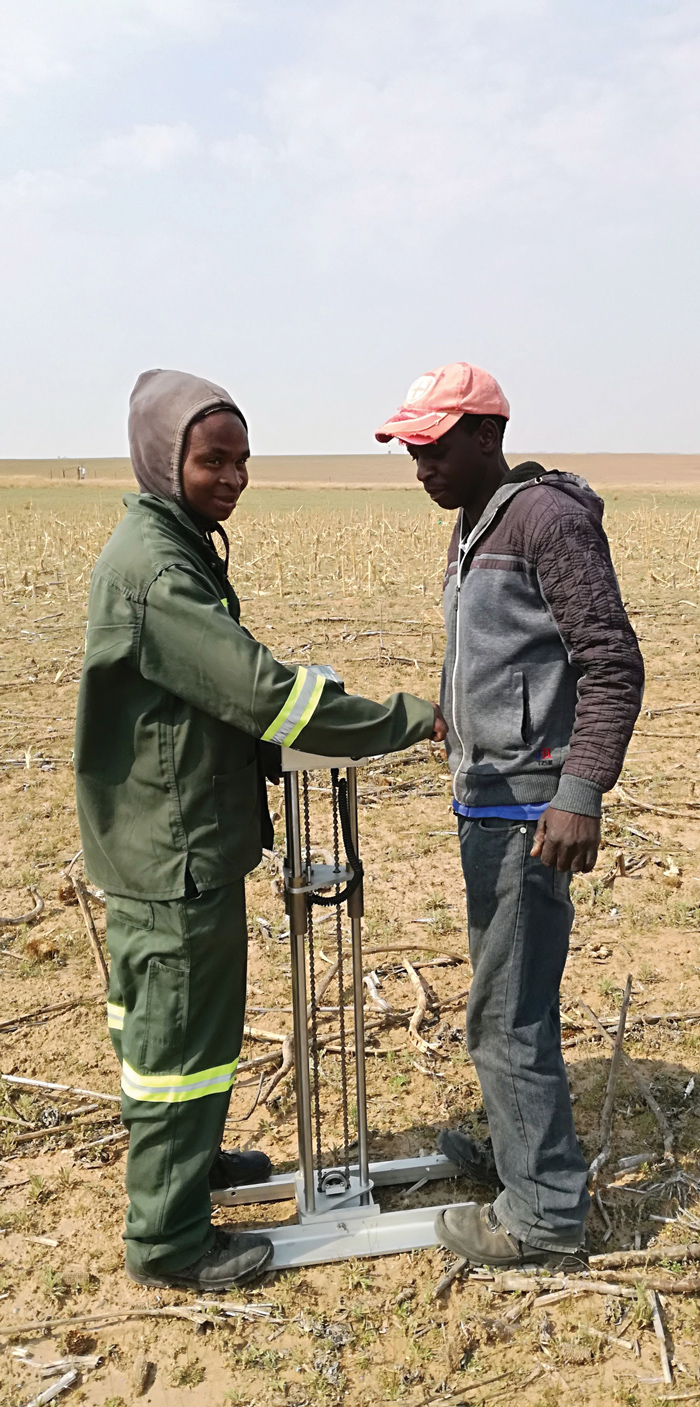
Prof Martin Steyn, professor in Agronomy, Department of Plant and Soil Sciences, University of Pretoria

Prof Jacquie van der Waals, programme manager: Preharvest Disease Research at Citrus Research International; and extraordinary professor: Dept of Plant and Soil Sciences, University of Pretoria

Mandla Sibiya,
PhD student, Department
of Plant and Soil Sciences, University of Pretoria

Knowledge Mushonga,
PhD student, Department
of Plant and Soil Sciences, University of Pretoria

Angelique de Wet,
MSc Agric student,
Department of Plant and
Soil Sciences, University
of Pretoria
The beneficial effects of crop rotation and residue management have been known for a long time. These benefits include improvement of soil physical conditions and soil nutrient status, control of runoff and soil erosion, and disease suppression on various crops.
Crop rotations have been practiced for centuries and were initially driven by the need to build up fertility levels through specific cropping sequences and to control weeds, pests and pathogens. The advent of synthetic fertilisers and crop protection products has enabled growers to focus more on the most profitable crops. As a result, growers have changed to more specialised monoculture production systems, with limited rotation in order to achieve highest economic returns.
Current economic, climatic and disease pressures have once again necessitated investigations into mixed cropping systems in order to achieve sustainable production. There is currently a renewed interest in crop rotation as a practice for more economically sustainable crop production, mainly due to its positive effects on the availability of soil water and nitrogen, lower weed pressure and more balanced soil microbial composition, which ensures the maintenance of a healthy root system.
Background and study methodology
Several previous studies have hinted to the fact that the response of crops to different rotation and tillage systems may vary, depending on the specific crops used, as well as the soil, environmental and climatic conditions. In the Western Cape, for example, better wheat performance in a crop rotation system was ascribed to improved soil organic carbon and nitrogen contents, which resulted in more vigorous crop growth and yield. Therefore, the development of region-specific rotation programmes is needed to ensure successful implementation of this practice. This requires long-term research, observation and adaptions to ensure more sustainable cropping systems for the future. Producers in the Eastern Free State have also expressed renewed interest in the use of crop rotation to enhance profitability and reduce financial risk related to mono-cropped maize.
Trial details
This study was initiated with the focus on potato and maize as major crops in a five-year rotation system. Potato is an important cash food crop in South Africa, and in the Eastern Free State it is mainly cultivated under dryland conditions. Potato is plagued by various soil-borne diseases and to ensure long-term sustainability, management practices should be centred on establishing and maintaining healthy soil to avoid consistently recurring diseases, achieve good yields and attain high economic returns. Therefore, the inclusion of non-host crops for potato pathogens in such rotations is of critical importance.
A long-term crop rotation trial with maize and potatoes in rotation with other crops was established in the Petrus Steyn district of the Eastern Free State five years ago. The aim of the study was to assess how different cropping sequences will affect soil chemical, physical and microbial properties over time in order to find the most optimal crop combinations that will ensure long-term ecological and financial sustainability of production in the Eastern Free State.

Selection of crops in the four five-year rotation sequences (maize-maize-fallow-wheat-potatoes; maize-sugar beans-maize-fallow-potatoes; maize-soybeans-maize-fallow-potatoes; and maize-sunflower-maize-fallow-potatoes) was based on crops that are already successfully grown in the area, as well as crops that showed potential to improve soil health and increase profitability of production in the region.
A field that was planted to potatoes during the 2015/2016 season (Year 0) was selected for the trial on the basis of land uniformity and relatively flat topography. The trial was laid out as a complete randomised block design and the four crop rotation systems were each replicated eight times, giving a total of 32 plots of ±767 m2 (35 m x 21,91 m) in size each. Potatoes were followed by maize on all plots in Year 1 (2016/2017), when the soil physical, chemical and microbial observations commenced. The crops in each rotation for the subsequent years are shown in Table 1.
 Observations
Observations
Crop rotation effects on crop yields and soil properties were evaluated by measuring various soil and plant parameters. Soil physical and chemical properties of the topsoil (20 cm depth) and subsoil (40 cm depth) were assessed at the end of each crop cycle. This included penetrometer resistance, bulk density, soil pH and soil nutrient status. Changes in physical and chemical properties, as well as soil nutrient depletion or increase over time were assessed for each rotation system.
Regarding changes in soil biological properties over time, various assessments were performed. Soil community microbial composition and activity were determined using the fluorescein diacetate (FDA)method and phospholipid fatty acid (PLFA) analysis. Legacies of rotations on soil factors associated with the suppression of important soil-borne pathogens were assessed using in-vitro antagonism and baiting assays.
Faba bean (Vicia faba L.) was selected as plant health indicator against Rhizoctonia solani and Fusarium graminearum inoculum in soils collected at the end of the 2018/2019 season. Faba bean is a good indicator species of the manifestation of Rhizoctonia stem and root rot disease development and symptoms in soils under greenhouse conditions. The Quantitative Polymerase Chain Reaction (qPCR) method was used to quantify DNA of important pathogens such as Rhizoctonia solani AG2-2IIIB, Fusarium graminearum, Sclerotinia sclerotiorum, and Streptomyces scabiei in soil samples.
Furthermore, the effect of different crop rotation sequences on the occurrence and abundance of common weed species in the area, such as Amaranthus hybridus, Senecio consanquineus, and Taraxacum officinale was assessed at the end of the 2018/2019 growing season. Crop yield data were collected at the end of each growing season and will be used in the calculation of gross profit margins for each rotation system.
The results obtained at the end of the first five-year rotation cycle of this long-term trial will be summarised in a follow-up article.
Acknowledgements: Funding by Potatoes South Africa, Department of Science and Innovation (DSI), the Technology Innovation Agency (TIA) and the Maize Trust.



























